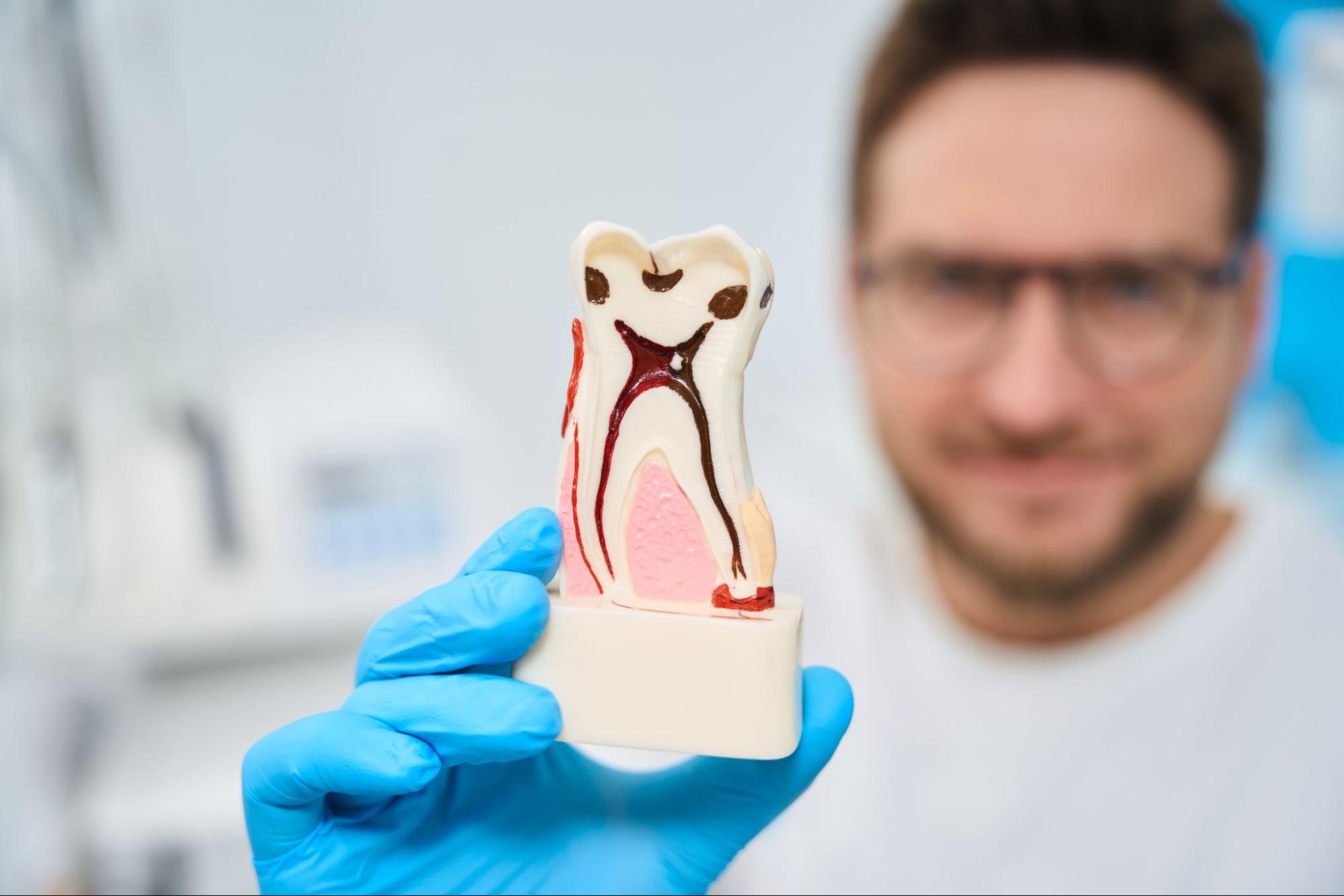Tooth pain can stop you in your tracks. It’s sharp, constant, or sometimes just a dull throb that refuses to quit. You don’t need to be a dentist to know something’s wrong. But understanding what that “something” is? That’s where most people get stuck. Confusion between cavities and root canals is more common than you’d think.
Why People Often Confuse Cavities vs. Root Canal Issues
It’s easy to mix up a cavity with a root canal issue. Both can hurt, and both involve a trip to the dentist. But they’re not the same, even if they share some symptoms. Understanding the overlap is the first step to better oral health.
The Overlap in Symptoms
Cavities and root canal infections can both cause pain. That pain might feel sharp or dull or only appear when eating. Sensitivity to hot or cold drinks is another common issue. For many, this makes it difficult to discern what’s happening. The symptoms often mirror each other, especially in the early stages.
Similar Triggers, Different Treatments
Sugar, poor hygiene, and bacteria lead to both problems. However, how they affect the tooth differs over time. Cavities eat through the enamel and can be stopped with a filling. Root canals occur when decay reaches the inner nerve, so the treatment plan progresses from simple to complex.
Misleading Views From Pop Culture and Word of Mouth
You’ve heard people say a cavity hurts like crazy. Others claim a root canal is pure torture. But pain levels vary, and myths blur the facts. Media and horror stories feed dental fear and confusion. It’s no surprise people think the two problems are one.
What is a Cavity vs. a Root Canal
Cavities are the starting point of tooth decay. They don’t always hurt right away, which makes them sneaky. Left alone, they continue to grow and cause even deeper damage. Recognizing one early can save you from serious procedures.
Definition and Causes of Cavities
A cavity is a hole in your tooth. It starts when plaque forms and turns sugar into acid. That acid wears down the enamel layer by layer. If you skip brushing or flossing, you’re at risk. Diet and dry mouth can also exacerbate the condition.
How Cavities Develop Over Time
Tooth decay doesn’t happen overnight. First, enamel starts to lose minerals. Next, a tiny hole forms and grows into dentin. Dentin is softer than enamel and decays faster. Eventually, bacteria reach the pulp and create significant issues.
How Dentists Treat Cavities
If caught early, a cavity can be reversed. Fluoride helps repair weak enamel in the early stages. Once it breaks through, though, you’ll need a filling. The dentist cleans out the decay and seals the area. It’s a fast and painless process in most cases.
Understanding What Happens in Cavities vs. Root Canals
A root canal sounds worse than it feels. It’s a repair process, not a punishment. It saves teeth from being pulled. The earlier it’s done, the better the outcome.
What Happens Inside the Tooth
Deep inside your tooth is the pulp, which holds nerves and blood vessels. When bacteria reach it, infection sets in. The pulp swells, causing pressure and pain. That’s when a root canal becomes the best option.
When a Root Canal Becomes Necessary
If a cavity is ignored, it digs deeper. Soon, the nerve gets inflamed or dies. You might feel a sharp jolt or throbbing that lingers. Swelling or a pimple on the gum can appear, too. At this point, a root canal is the only way to save the tooth.

The Root Canal Process
First, the area is numbed, so you feel nothing. Then, the dentist drills a small hole to reach the pulp. They clean out infected tissue and shape the root canals. The space is filled and sealed to prevent future problems. Most times, a crown goes on top for strength.
How to Tell the Difference Between Cavities vs. Root Canals
Tooth pain doesn’t always mean you need a root canal. Sometimes, it’s just a surface-level cavity. The clues lie in the type of pain and its duration. A dentist’s input makes all the difference.
Warning Signs That Point to a Cavity
When you eat sweets, your teeth may feel sensitive, but cold drinks might sting briefly and then fade. You might see a small dark spot or hole. Food often gets stuck in the teeth. The pain, if present, is usually mild and off-and-on.
Symptoms That Might Mean You Need a Root Canal
The pain is deep and lasts longer than a minute. It may wake you up at night or put you under pressure. Chewing becomes difficult due to soreness. The tooth may darken, or the gums may swell nearby. A bad taste in the mouth is another warning sign.
The Role of Dental X-Rays and Exams
Dentists don’t guess—they use tools. X-rays reveal the extent of decay and can detect infections or abscesses. A physical exam confirms if the nerve is affected. That’s how they decide between filling and root canal.
Why Prevention Always Wins in Cavities vs. Root Canals
You don’t need to end up needing either. Most cavities can be avoided with consistent habits. And root canals? They often follow neglected decay. Prevention is cheaper, easier, and way less stressful.
Daily Habits That Help You Avoid Both
Brush your teeth twice a day with fluoride toothpaste. Floss to remove food between your teeth. Drink water instead of sugary drinks. Avoid snacking all day, especially on sweets. These small things add up to big protection.
Importance of Regular Dental Visits
Your dentist can spot early decay before it causes pain. Regular cleanings remove plaque and hardened tartar and minor issues are addressed before they become more severe. Skipping visits means missing the early warning signs. Two trips a year make a huge difference.
How Fluoride and Sealants Add Extra Protection
Fluoride helps enamel fight acid attacks. It’s in toothpaste and many local water supplies. Sealants are thin coatings that block food and bacteria from entering. They go on the chewing surfaces of molars. Dentists often apply them to children, but adults can also benefit from them.

Long-Term Tooth Impact of Cavity vs. Root Canal Care
Treatments fix the problem, but what happens years later matters too. Fillings and root canals don’t restore your tooth to its original state. Each option affects strength, care routines, and even future costs. Knowing these differences can shape how you handle your dental health moving forward:
Tooth Strength and Durability After Treatment
A filling removes decay and seals the space, but the tooth is still weaker than before. If decay returns near the filling, it can spread more quickly through the softened tissue. A root canal saves the tooth but removes the living pulp, making it more brittle. Dentists usually place a crown to add strength and prevent fractures. Both options work, but they leave the tooth needing more care and attention than a healthy one.
Risk of Future Dental Issues
Teeth that have been treated once are more likely to need retreatment. Fillings can fail or loosen, allowing bacteria to re-enter the tooth. Root canal teeth are sealed, but reinfection can still happen, especially without a crown. Tooth cracks, missed canals, or delayed restorations raise the risk. Staying alert to small changes in treated teeth helps prevent future emergencies.
Cost and Maintenance Over Time
Fillings cost less initially, but they tend to wear down and need replacement. Over time, multiple fillings on the same tooth may lead to a crown. Root canals cost more upfront and often require a crown, but they’re intended to be long-term solutions. Repairs can be expensive if a crown cracks or the root canal fails. Long-term dental budgeting should consider the upfront and lifetime costs of each option.
Cavity vs. Root Canal Differences Across Age Groups
Age affects more than your bones and joints—it changes how your teeth respond to decay. Children, adults, and seniors each face distinct challenges in dental care. Treatment plans often vary depending on age, lifestyle, and tooth strength. Recognizing these differences helps families make more intelligent decisions for everyone at home:
What Cavity Risk Looks Like in Children
Kids are more prone to cavities because baby teeth have thinner enamel. Sugary snacks and skipped brushing add fuel to the problem. Cavities in baby teeth spread fast and may affect permanent teeth. Early dental visits and fluoride treatments help stop that chain reaction. Sealants on molars and consistent habits make a big difference early on.
How Adults Experience and Treat Decay
In adults, cavities often hide between teeth or under old fillings. Stress and busy routines lead to skipped cleanings or snacking on the go. Many adults delay treatment until the pain gets worse. That’s when a simple cavity can turn into a root canal. Keeping up with checkups is the best way to break that cycle.
Root Canal and Cavity Concerns in Older Adults
Seniors face new risks as gums recede and enamel thins. Medications and dry mouth make it easier for decay to start. Older teeth may already have fillings or crowns, which can complicate new treatments. Root canals in seniors often need extra care to protect brittle roots. Staying hydrated, using fluoride, and regular exams help avoid invasive treatments.
Protect Your Smile by Understanding Cavities vs. Root Canals
Pain isn’t the problem—it’s the signal. What you do next decides everything. Waiting gives cavities time to grow and turns minor repairs into major procedures. Getting ahead of the problem gives you more control and less pain. The choice isn’t between a filling or a root canal—it’s between reacting too late or responding just in time.
Want honest answers about your teeth? Visit the Meader Family Dentistry blog for clear, practical guidance.






